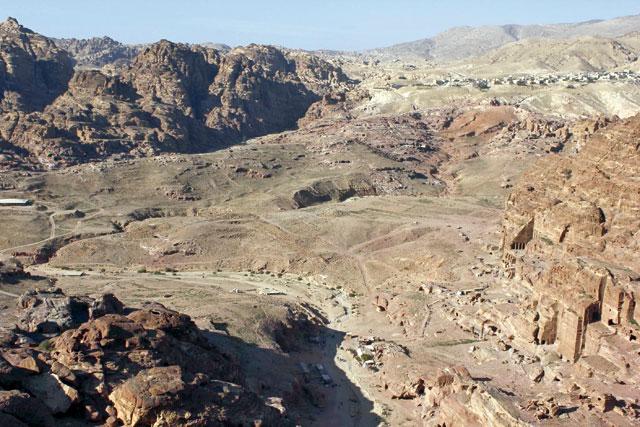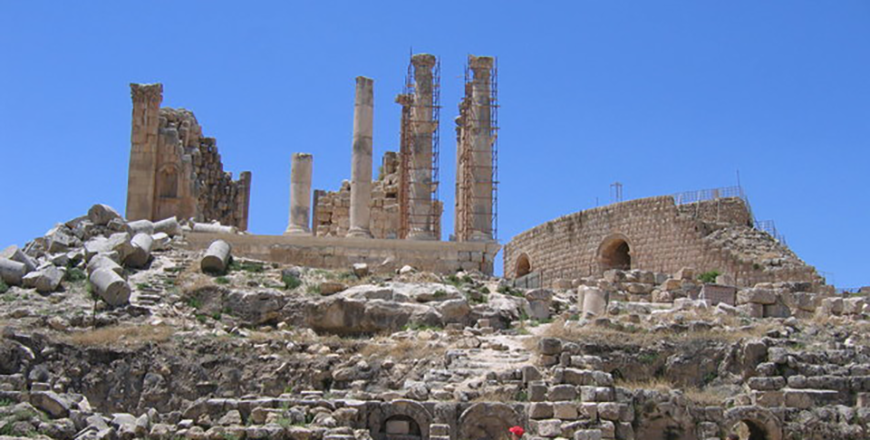You are here
Survey reveals architectural wealth of Petra region
By Saeb Rawashdeh - Feb 15,2018 - Last updated at Feb 16,2018

The aerial view of the Petra Valley, the Shara Mountains, town of Wadi Musa and the Great Temple (Photo courtesy by S.G. Schmid)
AMMAN — Since 2010, a research team from the Northeastern Petra Project (NEPP) has been conducting an intensive survey on the high hill overlooking the eastern end of the Colonnaded Street, and westward of the Palace Tomb in Petra, said Zbigniew Fiema, one of the NEPP co-directors.
The site, which covers approximately 450 x 400 metres, is generally known as Rujm Umm Al Unaydiq, he explained, noting that "although a number of monumental buildings once existed in this area, they were never properly documented".
The NEPP survey revealed the existence of 19 large buildings of exceptional design and architectural decoration, the quality of which favourably compares with the most significant buildings in Petra as well as with palatial structures in the eastern Mediterranean during the Hellenistic-Roman period, Fiema continued.
The NEPP area was separated from the rest of the city centre by the Wadi Mataha and the Wadi Musa drainages, the scholar elaborated, stressing that the isolated area was self-sufficient in water supply and easily defensible.
According to the scholar, who received his PhD in archaeology from The University of Utah, the NEPP area was uniformly occupied in regard to the architectural design and decoration, as well as to surface ceramic material.
"All these elements are dated to the late 1st century BC–1st century AD," Fiema said.
The majority of the NEPP buildings are characterised by the monumental architectural design which reflects a high degree of ostentatious display, representation and wealthy lifestyle, rather than purely utilitarian habitation, the scholar underlined, noting that the buildings in the NEPP area were components of a single architectural complex of a palatial type.
"The characteristics of the buildings mentioned above indicate that the complex was most probably built and inhabited by the elites of the Nabataean Petra," the archaeologist elaborated, highlighting the monumentality of the NEPP buildings which is demonstrated by the enormous deposits of building blocks marking the wall lines.
He also cited a large number of decorative elements including column drums, doorjambs, column and pilaster capitals and bases, decorative freezes, voussoirs, among others.
"The two largest structures, located on the top of the hill, which dominate the complex and are characterised by the wealthiest architectural decoration, might have served as main reception halls or banqueting space," Fiema speculated.
The clearance of a room in one of these buildings revealed a luxuriously decorated space, including flagstone pavement on the ground level, mosaic floor in the upper storey as well as painted wall plaster, and architectural decoration blocks of highest quality, he continued.
For Fiema, the interpretation of the NEPP complex is not easy without excavations, but some preliminary interpretations can be proposed.
"With regards to the main urbanistic features, the NEPP complex resembles a "basileia" [the royal quarters] in the Hellenistic cities such as Antiochia and Seleukia in Syria, Babylon in Mesopotamia, and Alexandria in Egypt," the scholar elaborated.
Generally, elements of constructions and architectural decoration of the NEPP buildings reflect the styles and fashion characteristic for the palatial architecture in the East during the 1st century BC and the 1st century AD, Fiema underlined.
"These features find parallels in some Hasmonean and Herodian country palaces (e.g., Jericho, Herodium, Masada) and in some Late Republican-Early Imperial palatial complexes in Italy," he continued, noting that "the NEPP architectural complex appears as a unique hybrid of ideas, designs and engineering solutions".
In spite of the use of fashionable Hellenistic-Roman design and decoration, the complex possesses a strong Nabataean character which is clearly demonstrated in the skillful landscaping of the rocky and uneven terrain and the use of water as a decorative element, Fiema said.
The NEPP is now preparing publications about the research conducted so far as all structures have been documented and mapped and the collected surface material described and assessed, he concluded.
Related Articles
AMMAN — A team of scholars involved in the North-Eastern Petra Project (NEPP) investigated for the first time a whole quarter of the ancient
AMMAN — Between 1997 and 2013, the Finnish Jabal Haroun Project (FJHP) has carried out archaeological excavations at a Byzantine monastery l
AMMAN – Syntheses of ancient Jerash and its urban spread are based largely on studies of monumental ruins, most of whose visible and imposin



















